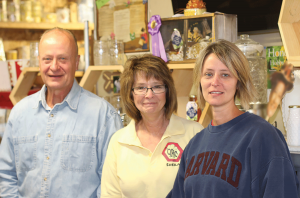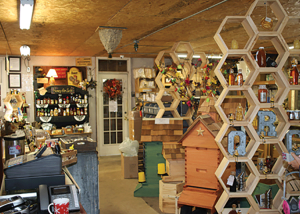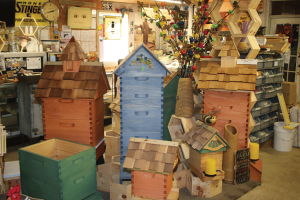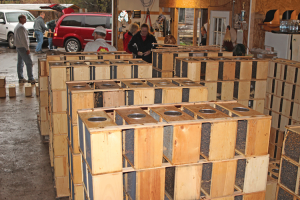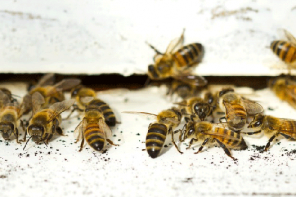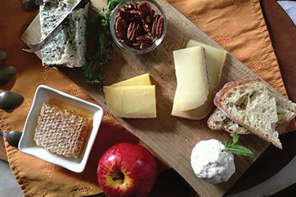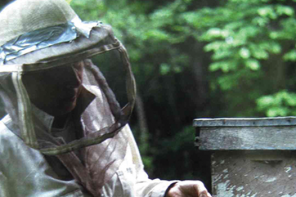By: James Tew
I can’t say just how long it has been, but I have known Shelia and Denzil St. Clair at Queen Right Colonies (QRC) in Spencer, Ohio, for many years. Though all those years, Queen Right Colonies has steadily grown and evolved into a diversified education and supply company. From a simple early start, the company has now grown into a complex that readily serves as both a supply stop and a tour stop. Equipment, bees, education, and an eclectic collection of products and animals are main attributes of this business.
Things are always changing at QRC. For a while, meetings were conducted in a vintage Ohio barn with room for animals, farm equipment, and beekeepers. They even included a premier parking space for visiting speakers. This remains the only time in my career that I was allocated a special parking space. I will not forget this experience.
Denzil –
QRC Philosophy
I will never forget making my first trip from Cleveland to the A.I. Root Company. I remember the excitement and expectations about a new adventure. Arriving at Root, the sights and smell of wood and wax, and actually seeing and touching beekeeping equipment plus the wonder and the possibilities seemed endless for a young and novice beekeeper. I want to give people that same feeling of awe and wonder as they arrive and continue to come to QRC, the feeling of a kid in a candy shop. To do that, we continue to change the appearance of QRC. When you arrive here, you will never know what to expect in the product line, livestock, or buildings.
QRC Commitment to Beekeeping
I have been president of the Lorain County Ohio Beekeepers Association (LCBA), an organization that was founded in 19191. I started the Greater Cleveland Beekeepers Association2 (GCBA) and support all local organizations. GCBA conducts a free Field Day in conjunction with LCBA every year at QRC. We have several free classes throughout the year and speak regularly whenever possible. Primarily QRC is a retail facility and teaching business. While we maintain about 30 colonies on site, these are for instructional purposes only.
QRC the Business
QRC is a five generations beekeeping family and four generations of St. Clairs have worked at QRC. I have told many that my wife’s grandfather is responsible for QRC. When we were married in 1971, Benjamin H. Campbell gave us two colonies of bees. We moved these hives in the back of a Ford Fairlane from Kentucky to Brunswick, Ohio.
The business itself is unlike any other. Where else can you go to buy an item whether it is a hammer, car, washing machine, or hive tool and walk with Fallow and Muntjac deer, cattle, horses, and other creatures great and small. In the past three years, we have demolished two buildings and built three new structures. We have added five acres of land and a new warehouse (which is already packed with bee supplies).
QRC Bees
We have had a great opportunity for the last 10 years to work with Ray Olivarez in northern California and supply beekeepers with what we think to be the best package bees in the industry, but, of course, we are very biased. We supply several semi loads of bees every year to experienced and novice beekeepers alike; and we still ship bees anywhere east of the Mississippi. This is becoming a greater challenge as more and more bee supply companies and package bee operations drop the package bee shipping aspect of their business.
A Bit of History
In March, which is usually mild in Kentucky, Shelia St. Clair’s grandfather, Mr. Campbell, was an older beekeeper who walked with a cane. When he learned that Denzil liked animals and was curious about bees, of course, he immediately had to show Denzil his bees. As they reviewed the apiary, he decided to check to see if his hives had survived the Winter.
Mr. Campbell had a tiered setup in his apiary. When working his bees, he had just enough room for a walkway for himself. As Denzil followed, Mr. Campbell would rap on each hive to see if bees would come out. As the two of them – in single file – stepped forward from hive to hive, Denzil was required to stand in front of the hive that had just been disturbed. More and more bees took flight with Denzil – knowing nothing about bees – in the middle of the fracas. He told me that as he and Mr. Campbell moved farther down the narrow row with more and more bees in the air, he moved in closer and closer to his grandfather-in-law until he was breathing down his neck. Because Mr. Campbell blocked him, he could not move forward. Since the path behind him was a cloud of bees, he had to see this journey through. Remember, neither had veils or smokers. It ended happily. This was Denzil’s very first experience with bees and the beginning of his interest in honey bees.
When the St. Clairs married in 1971, Mr. Campbell gave the newlyweds two hives of bees. The bees were loaded into the trunk of the car and hauled home. As has happened to so many of us, the St. Clairs were novice beekeepers. As it worked out, Sheila’s dowry was two beehives.
As young couples often do, they moved a number of times, and it was not long before the two moved back to Cleveland. At that time, bees could not be kept within the city. By the time he and Shelia were in Cleveland, the bee bug had hit him. He gave the two hives to his brother for safekeeping. To meet his bee needs, he set up an observation hive in his upstairs apartment and ordered his bees through the mail.
The day the bees arrived, Denzil happened to see the postman make the delivery. He waited a bit for the doorbell, but no ring. What he saw was the postman departing, he opened the door. The postman said that he did not knock because he did not care if anyone was home or not – he was out of there!
The couple continued to move and the observation hive went with them. Eventually, they settled in an upstairs apartment at his parent’s home. In the early Spring, a neighbor began to complain. Because the sun struck the wall of his house, bees would fly from the shaded side of the St. Clairs’ apartment to the sun-warmed wall of this neighbor’s house, “making the neighbor crazy.” Denzil’s Dad felt bad for the neighbor, so he bought him cans of insecticide spray to control the bees on his house.
The observation hive became too much of an issue so the next move was to put a beehive on the top of the flat-roofed garage away from the house. Of course, this was not legal at the time. The rooftop apiary grew to two colonies. When the St. Clairs moved to their present location in Spencer, Ohio, the bee operation mushroomed to 200 colonies. These were used for pollination and were trucked all over the state.
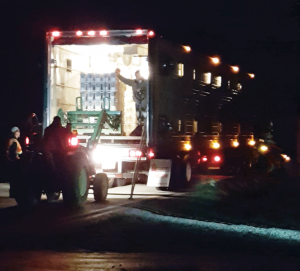
No matter what time, the semi from California is unloaded and the drivers immediately head back. The trailer is custom built with digital information concerning the load. The packages travel in humidity and temperature-controlled environment. The bees arrive in beautiful condition.
Once he was late for a pollination colony pickup. Since he had bees scattered in several pollination locations, he abruptly decided to move these late colonies from an orchard. The evening was late without light, and interestingly, Denzil planned to do the job with no protective gear and smoker. No, the hives were not closed up. He said he did not move colonies closed up.
It is important for you to know that the orchard owner did not know that Denzil was coming for his bees. Indeed, the owner was not even home. Denzil moved his trailer to the vicinity of the hives and went about his work.
It became hard dark, but the ramp was down, and colonies could be rolled up onto the trailer – when without warning he heard a shout, “Who’s out there!! Who’s out there!! Boom! Boom!” (12-gauge shotgun retort). Denzil shouted that he was only picking up his bees. The dogs were going crazy. After calming down and stowing the armaments, the owner offered to help but that was neither practical nor safe. In general, it seems that a lot of shooting, shouting, stinging and barking was ongoing; just a typical beehive move.
After the excitement ebbed, almost immediately, Denzil dropped a colony and having no gear, he was being crazy stung. Bees were everywhere. He reestablished the colony and dropped it again. The bees were disgusted while Shelia stayed in the truck. Much like his earlier experience with Mr. Campbell where he could not turn back, Denzil could only suffer through this episode. To this point today, Denzil feels that this was the worst bee night of his life. Shelia concurs.
During this phase of his bee life development, Denzil began to have the conception that selling bee equipment might have potential. At that time, the Root Company in Medina had stopped manufacturing bee supplies. This required many Ohio beekeepers to purchase equipment to be shipped to them. His initial idea was to buy equipment in volume, use what he needed, and sell the remainder. A corncrib was his first bee supply building. On his first order he bought 50 deeps and worried about selling it; but it did sell, and demand grew and grew. Denzil and Shelia began building (and building) new facilities and adding to others. Additional property was acquired and a large warehouse was purchased. With each addition, it was felt that this would be the last. Not so. Even now, all buildings are filled, and customers come in steady streams. The next initiative may be to perform in-house milling and manufacture wooden equipment. This advance is still in the idea phase. Additionally, office space may be increased.
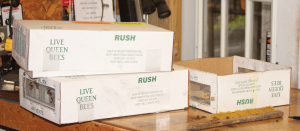
Approximately 2,000 queens are sold per year. If desired, they are hand-marked with the proper color at the facility.
The St. Clairs are very complimentary about the relationship they have developed with many of their customers. Customers who come in share their experiences, their backgrounds, and their beekeeping stories. The couple has served as president of the Lorain Beekeepers Association, a one hundred year old organization. Additionally, they have been instrumental in initiating other bee organizations and establishing educational programs at their facility.
QRCs staff now sells 3600 to 3800 packages and about 2000 queens per spring season. Denzil and Shelia now keep about 30 colonies for training, experimentation, and demonstration. This couple made a conscious decision to move to equipment sales rather than pursue the honey production/pollination aspect of beekeeping.
Denzil’s overview comment is that Queen Right Colonies does a lot more than sell bee supplies. They provide tours, have developed an impressive menagerie of animals, carry a complete line of books, and conduct educational programs. They change a lot, too. QRC is constantly evolving and changing. The St. Clairs hope their operation will always be an enjoyable stop both for beekeepers and anyone interested in animals, bees, and a unique and diversified inventory of both practical and whimsical items3. It is a very pleasant stop for anyone interested in bees and specialty barnyard animals.
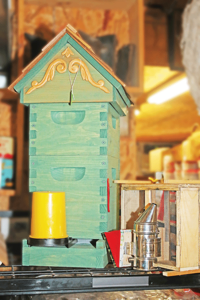 The QRC Small HiveThe St. Clairs have developed a small hive concept with smaller accessories.
The QRC Small HiveThe St. Clairs have developed a small hive concept with smaller accessories.
Ostensibly, it would be for children who are a bit older, but I could see where it could used for senior beekeepers, queen breeders, or beekeepers who are putting together a display at fairs or farm shows.
The unique hive is available as an ornamental hive. Simpler versions of the hive are also offered. As with other QRC standard hives, pastel wood stains are available that give the hives a pleasingly colorful look.
How would it work during and after Winter? Will swarming be a problem? How tall can it be stacked? Some basic answers are not yet available, but the challenges that may be presented are none that beekeepers have not dealt with when managing traditional hives.
1Lorain County Beekeepers Association http://www.loraincountybeekeepers.org
2Greater Cleveland Beekeepers Association http://www.greaterclevelandbeekeepers.com
3For more photos, see: https://onetewbee.smugmug.com/organize/Bee-Culture-November-2016
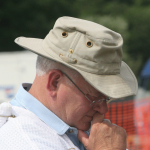 Dr. James E. Tew, State Specialist, Beekeeping, The Alabama Cooperative Extension System, Auburn University; Emeritus Faculty, The Ohio State University.
Dr. James E. Tew, State Specialist, Beekeeping, The Alabama Cooperative Extension System, Auburn University; Emeritus Faculty, The Ohio State University.
One Tew Bee RSS Feed (http://www.onetew.com/feed/);
FaceBook http://www.facebook.com/tewbee2;
Tweeter: @onetewbee








